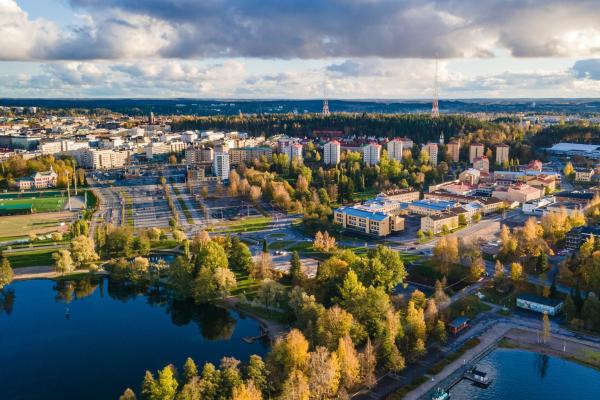“With the carbon neutrality project, the Lahti Symphony Orchestra wants to act as an encouraging example of the fact that a wide variety of actors can find suitable ways to take action against climate change. Our goal is to gradually change our operations to become the first carbon-neutral orchestra in the world,” says Lasse-Matti Laakso, Violist in the carbon-free Lahti Symphony Orchestra."
In 2015, in celebration of the 150th anniversary of the Sibelius Hall, the Lahti Symphony Orchestra initiated a project to help the City of Lahti reach its carbon emission reduction goals. With the help of Myrskyvaroitus, an organisation that seeks partnerships in the areas of art and culture to fight against climate change, the ‘Carbon-Free Lahti Symphony Orchestra project’ was born. The project is promoted by the founding members of Myrskyvaroitus, the communication and event specialist Hannele Eklund, and the energy expert Dr Jouni Keronen.
The Lahti Symphony Orchestra is “taking the lead as an environmentally responsible artistic organisation by adopting carbon neutrality as one of its operational objectives,” says Sinfonia Lahti.
Teemu Kirjonen, the Orchestra’s General Manager, sees the project as a natural part of the City of Lahti’s climate strategy. The project involved all of the Orchestra’s musicians and administrative staff, as well as partners including the Lahti-based Environmental Technology unit of the Lappeenranta University of Technology (LUT).
Becoming carbon-neutral
To kick start the project, LUT helped calculate the carbon footprint of the orchestra. The principal sources of greenhouse gas emissions were identified in order to find a way to reduce these emissions and explore the orchestra’s potential to influence its partners in reducing their carbon footprints. Following the calculations, emission loads were reviewed, and an action plan was created to address each.
- Transportation
Loads: Staff commuting, concert touring and audience attendance at concerts accounted for approx. 60 % of the transportation load.
Actions: The staff and audience are encouraged to use public transportation; office staff are urged to telecommute; and green energy transport providers are utilised for concert touring when possible.
- Energy
Loads: Administration and Orchestra performance and rehearsals.
Actions: Installing LED lighting; employing efficient recycling; and switching-off electrical and electronic devices when not in use.
- Acquisitions
Loads: Lighting, sound systems and other services.
Actions: Clean technology should be a criterion in new acquisitions.
- Promotional products
Loads: Printed materials (programme booklets, season brochures, posters, etc.), as well as t-shirts and other textile products.
Actions: Employ environmentally responsible service providers.
In 2017 the Lahti Symphony Orchestra partnered with the UN Framework Convention on Climate Change (UNFCCC) Secretariat’s ‘Climate Neutral Now initiative’. The initiative, run in co-operation with the Myrskyvaroitus, enables concert ticket buyers to offset part of their carbon footprint through a ‘Green Button’ campaign. When concert goers purchase their tickets online via Ticketmaster Finland, they can donate through Myrskyvaroitus to the UNFCC’s internationally certified development projects, combating climate change.
“The Carbon-Free Lahti Symphony Orchestra is a unique, pioneering undertaking which, hopefully, will encourage other artistic institutions to participate in the reduction of greenhouse gases,” says Sinfonia Lahti.
Discover all the Citizen Diaries from Lahti

Valtteri Bottas began his career when he was just six years old, racing karts in his hometown of Nastola in Finland.

In the winter of 2016, Eetu Floor was walking to a friend’s band practice in Lahti. On his way there, he chose a shortcut through the industrial area of Sopenkorpi where he found an overgrown industrial track and plot.

The Lahti Pelicans is a Finnish professional ice hockey team that plays for the City of Lahti, in the ‘Liiga’, Finland’s top professional ice hockey league.

Emmi Valli-Forsback from Lahti buys almost all of her family’s clothing and household goods second-hand; and rents a market stall to sell on what she no longer needs. She rarely considers buying something new if she can find it second-hand.

Bee doctor Kamran Fakhimzadeh knows what a miracle honey is: to produce a kilo of it, bees have to visit up to ten million flowers. At the same time, bees do us a huge favour by pollinating vegetables and fruit and berry plants.

Rikka-Liisa Aalto has always picked up litter in her local area. After becoming a mother, she started picking up litter almost every day. The Puhdas Päijät-Häme network was born out of a desire to make a connection with other people who care about the environment.

In 2015, in celebration of the 150th anniversary of the Sibelius Hall, the Lahti Symphony Orchestra initiated a project to help the City of Lahti reach its carbon emission reduction goals.

Fashion designer and entrepreneur Riikka Flink has been observing the clothing industry for over 30 years. She believes that ecology, sustainability, and responsibility are possible when production is closely monitored.


